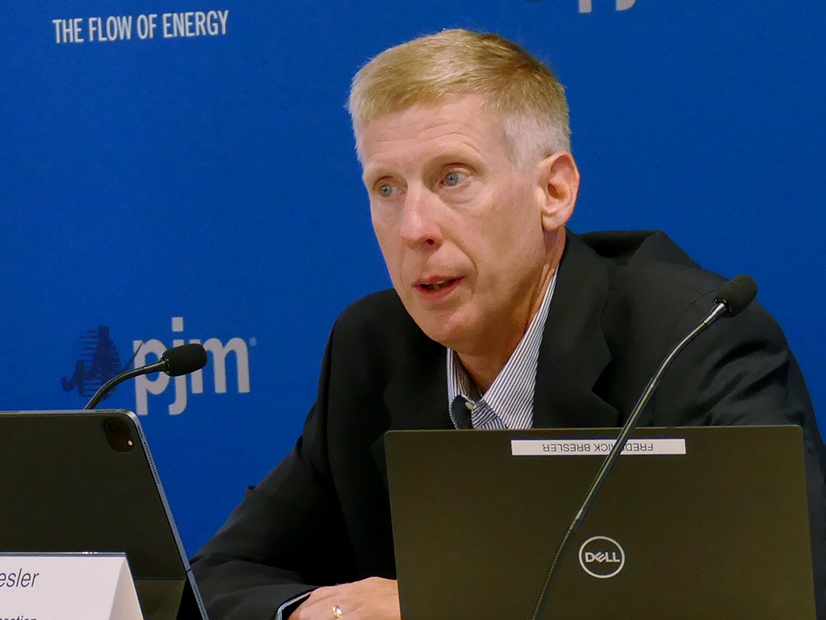The Members Committee was sharply divided on an agreement in principle between PJM and Pennsylvania Gov. Josh Shapiro to institute a cap and floor on capacity prices for the 2026/27 Base Residual Auction (BRA) and the following auction.
The Feb. 7 consultation with the Members Committee allows PJM to move one step closer to filing the agreement at FERC under Federal Power Act Section 205. The MC meeting was followed by a closed-door consultation with the Transmission Owners Agreement Administrative Committee (TOA-AC). (See PJM, Shapiro Reach Agreement on Capacity Price Cap and Floor.)
The proposal initially would limit prices to between $175/MW-day and $325/MW-day, values that are tied to the accreditation of a dual-fuel combustion turbine (CT) generator and could change with time.
PJM Executive Vice President Market Services and Strategy Stu Bresler said the agreement would improve confidence in market outcomes as FERC considers several market designs the RTO has filed and complaints about the capacity market — including one from Shapiro’s administration. Without an agreement on the commonwealth’s complaint, he said there could be further delay in the 2026/27 auction schedule, or the results could be subject to refund.
General Counsel Chris O’Hara said Shapiro’s administration has committed to withdrawing its complaint if the agreement is accepted by FERC, which could come in the form of a contingent notice of dismissal. The Pennsylvania complaint seeks to revise the auction price cap to be set at 1.5 times the net cost of new entry (CONE), rather than the greater of gross CONE or 1.75 times net CONE (EL25-46). (See Pennsylvania Seeks Lower PJM Capacity Price Cap in FERC Complaint.)
The agreement is focused on the next two auctions, Bresler said, because of a confluence of circumstances likely to limit the amount of new entry. Those include the short time period between BRAs and the corresponding delivery years under the compressed auction schedule and the backlogged interconnection queue. He said both are temporary as PJM holds a goal of returning to three-year forward auctions and as it works through a transitionary process meant to shorten the timeline for studying new interconnection requests.
“This is proposed as a temporary solution for the next two BRAs … we believe not moving forward with this settlement would have been untenable,” Bresler said.
PJM plans to file the proposal at FERC on Feb. 14. That could be delayed if it determines it would be preferable to see how the commission acts on several other filings first. Vice President of Market Design and Economics Adam Keech said a FERC order on the RTO’s proposal to revert the reference resource to a dual-fuel CT, instead of a combined cycle (CC) generator, would be especially noteworthy. Even if the reference resource change is rejected, Keech said PJM likely would seek to continue basing the proposed price cap and floor on a CT.
Denise Foster Cronin, of the East Kentucky Power Cooperative (EKPC), said PJM’s motivation is to provide short term relief for consumers, but she’s concerned this is a fundamental change in the auction design that will undercut reliability and ultimately lead to much higher prices in the long term, starting as soon as 2028. Infusing additional uncertainty into the market for those who must make investment decisions now will stymie much needed investment in new and existing resources. Additionally, in relying upon generators in Western PJM to supply load centers in Eastern PJM subject to the price cap, she said this proposal effectively requires Western generators to subsidize load to achieve the purported short-term savings.
Paul Sotkiewicz, president of E-Cubed Policy Associates, said the capacity market was created in part to address state rules and standards that could have compromised resource adequacy by creating a stable market design that allows the impact of those policies to be reflected in price signals. Instead of holding to that history, he said PJM has arrived at a settlement drafted without including its membership, which would lead to fewer resources being committed.
“We’re shifting and transforming price risk into reliability risk for political expediency,” he said.
If it moves forward with the agreement, Tom Hoatson, of LS Power, recommended PJM clear the auction normally, publish the clearing price, and then truncate the results to fit within the cap and floor. Doing so would allow investors to have greater insight into the market dynamics, while still meeting PJM’s goals driving the settlement.
“It’s just information that we need to understand to determine how we should invest in these markets,” he said.
Consumer advocates questioned the need for a floor on prices, with Greg Poulos, executive director of the Consumer Advocates of the PJM States, saying that even if the auction cleared at the proposed floor, that would remain one of the highest clearing prices the capacity market historically has seen.
“This is an extremely high floor to incentivize resources in that perspective,” he said.
Ryann Reagan, of the New Jersey Board of Public Utilities, said the BPU takes seriously the resource adequacy concerns PJM has laid out in recent years and the focus on high prices. However, if the price floor does turn out to be relevant it would indicate there’s been a fundamental misreading of market conditions. If that were the case, he said consumers should not be expected to pay higher prices than necessary.
Bresler said PJM has conducted a lot of analysis over the past two years showing supply and demand are tightening in an accelerating manner. To achieve a solution mutually beneficial for market sellers and buyers, it needed to address the legitimate consumer cost concerns and also sustain any new entry possible in PJM over the next two years.
“We feel that it is really important to ensure that we really address both sides of the equation,” he said.
Senior Vice President of Governmental and Member Services Asim Haque said PJM and the Shapiro administration reached an impasse during negotiations on the agreement, leading them to seek input from market sellers. When pressed by stakeholders, he declined to provide more detail on which market participants were included in the discussion other than stating it was a broad swath.
“This was input to our discussions around the concept of investment [and] economics in the marketplace. The easiest way to think about this is we don’t build anything, and the Shapiro administration doesn’t build anything,” he said.
Jackie Roberts, federal policy advisor for the West Virginia Public Service Commission, said she does not believe settlement privilege would extend to entities not party to the agreement who provided insight that informed its terms. She argued the fact that PJM spoke to other suppliers isn’t privileged and the RTO owes it to the members to tell them who it spoke to. She asked that any explanation of why this is not the case be supplied in writing to the Organization of PJM States Inc.
Independent Market Monitor Joe Bowring said he supports the agreement, subject to appropriate implementation, and believes it would be consistent with a competitive market result. The variable resource requirement (VRR) curve always has included maximum prices.
“The argument has been about what that maximum price should be. IMM analysis has shown that PJM’s proposed maximum price of about $600 would result in a wealth transfer from customers to generations of about $8.7 billion per year with no achievable incentive effects,” he told RTO Insider.
He compared the agreement to a recommendation the Monitor has made in its analysis of the 2025/26 BRA results that PJM revise the formula defining the maximum price to be 1.5 times the net CONE, rather than the greater of gross CONE or 1.75 times net CONE, although he said the agreement would result in maximum prices 14% higher than the Monitor’s proposal. Bowring told RTO Insider he’s opposed to minimum prices in the auction design.
“The agreement would set the maximum price on the VRR curve at a level consistent with the capacity market design. The maximum price of $325 is almost three times higher than the weighted average capacity auction price over the history of the capacity market, $116.30,” Bowring said. “PJM’s implementation of the agreement is not consistent with an agreed on maximum price of $325 because PJM converts the price from UCAP to ICAP, making it subject, for no good reason, to changes in ELCC ratings.”



